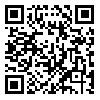BibTeX | RIS | EndNote | Medlars | ProCite | Reference Manager | RefWorks
Send citation to:
URL: http://refahj.uswr.ac.ir/article-1-1861-en.html
Objectives: Child abuse is a complex phenomena and one of the most serious social pathology that resulted from multiple factors in familial, psychological and social domain. In this research the effective family factors on the child abuse are identified .Then on this basis with a preventive outlook, scientific and applied tactics are presented .Through different psychological and sociological theories include Violence cycle, Self attitude, Resource, Social control, Exchange and Social structure which everyone tells the theorical frame, it was chosen in the case of integrating. Method: The research method of this study is a case control kind. The statistical society is comprised of two groups: The abuser parents (case group) and non-a(control group).In fact the study population of this research include all parents whose children are students in one of guidance schools education organization 15 district of Tehran .The sample is 382 selected .Among all schools (male&female) 6 schools were randomly selected using multistage cluster sampling method then in each school one class of 1, 2 and 3 elementary level randomly were selected then students completed child abuse measuring questionnaire. After analysis information 40 students that had the most abuse grades were selected as case group, 40 students that had the least abuse grades were selected as control group. By using T test there was significant difference between two groups in violence. Then questionnaire was completed by the parents of two groups in order to effective family factors contributing to the child abuse. After making a list and confirming the validity of questions by professors of social work and sociology, its reliability was confirmed through cronbach alpha coefficient. This information is gathered by systematic interviews. For data analysis and testing the hypothesis Independent Samples T Test and chi – square ( ) were used for describing the study population and from descriptive statistics. Spss software type 15.0 was used for data's reductions. Finding: According to statistical analysis of the data, the main result was obtained: there was significant difference between abuser parents and non abuser parents in variables such as violence experience in their family, rate awareness of child growth period trait, rate access to social supports, social isolation and number of family members but there wasn’t significant difference between two group parents in self confidence and social class. Results: Based on the comparative study and results Independent Samples T Test showed there is statistically significant difference between abuser parents and non abuser parents on factors of violence experience in their family, rate awareness of child growth period trait, rate access to social supports, social isolation and number of family members but there wasn’t significant difference between two group parents in self confidence and social class. .in fact they are the effective main factors for the child abuse. To prevent this social pathology, we need to raise the awareness of parents regarding the appropriate ways to contract with their children. We also need to identify and protect the vulnerable families.
Received: 2015/08/24 | Accepted: 2015/08/24 | Published: 2015/08/24
| Rights and permissions | |
 |
This work is licensed under a Creative Commons Attribution-NonCommercial 4.0 International License. |





